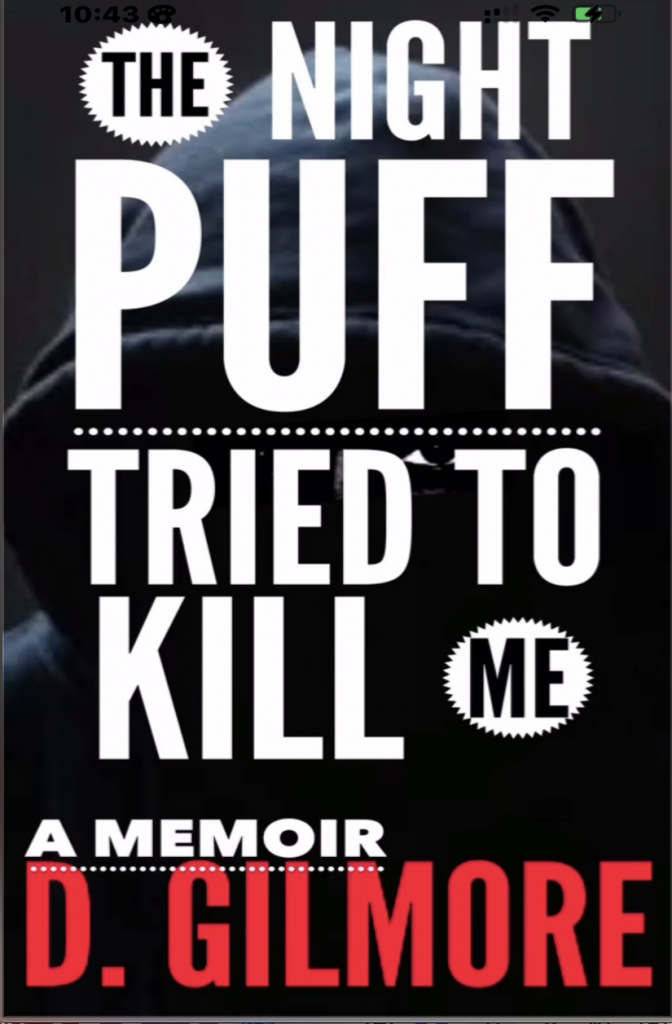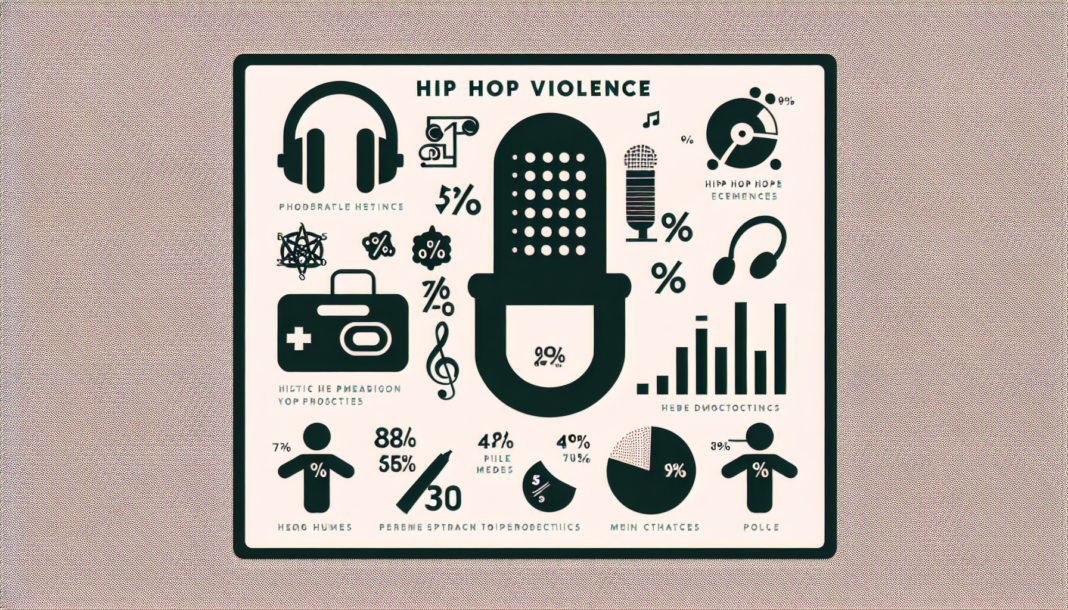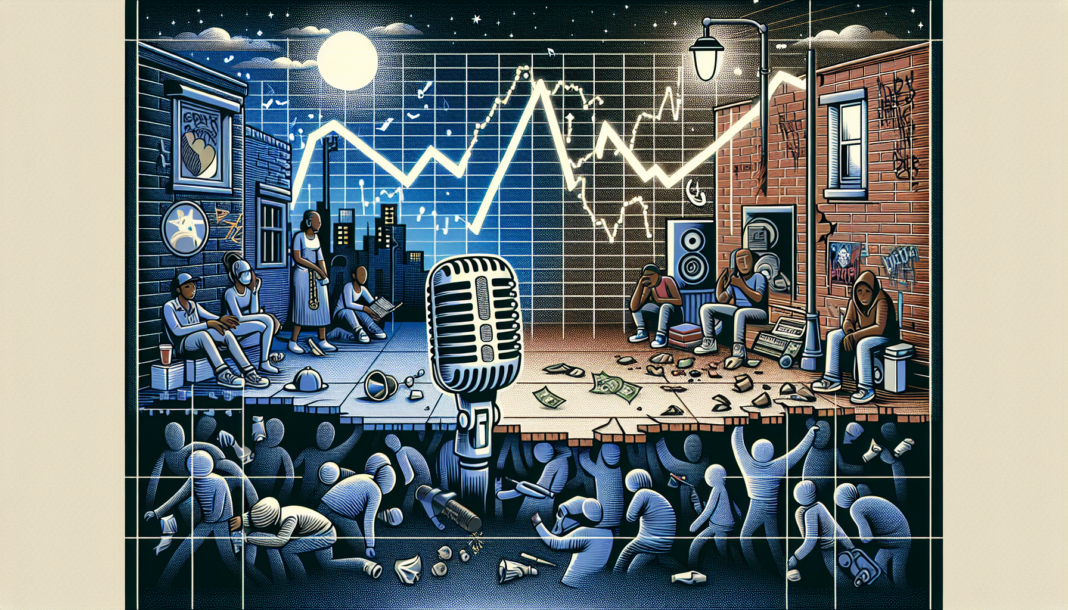The Intersection of Hip Hop and Violence
Delving into the historical backdrop of hip hop and violence provides crucial insights into how these elements have intertwined over the years, shaping the narrative and identity of the genre.
Historical Context of Hip Hop and Violence
The journey of hip hop over the past five decades has been marked by a complex relationship with violence. Originating in marginalized communities in the Bronx during the 1970s, hip hop emerged as a powerful expression of urban struggles, giving voice to social issues, including poverty, racism, and violence.
| Decade | Key Events in Hip Hop and Violence |
|---|---|
| 1970s | Rise of hip hop in the Bronx amidst economic turmoil and gang violence. |
| 1980s | Emergence of gangsta rap portraying street life, crime, and violence. |
| 1990s | Heightened debate on explicit lyrics, glorification of violence, and societal impact. |
| 2000s | Continued exploration of violence in hip hop with shifts towards introspection and activism. |
| 2010s | Increasing focus on social justice issues, police brutality, and systemic violence. |
| 2020s | Hip hop as a platform for community empowerment and advocacy against violence. |
Impact of Violence on Hip Hop Culture
Violence has deeply influenced the evolution of hip hop culture, shaping lyrical content, visual aesthetics, and societal perceptions. The portrayal of real-life struggles, trauma, and resilience in hip hop lyrics has provided a platform for artists to address issues often overlooked in mainstream discourse.
Despite facing criticisms for glamorizing violence and perpetuating negative stereotypes, hip hop has also served as a mirror reflecting the harsh realities of marginalized communities. Through storytelling and poetic expression, artists have shed light on systemic inequalities, racial injustice, and the cyclical nature of violence in urban environments.
By examining the historical context and impact of violence on hip hop culture, one can gain a deeper understanding of how this genre has become a powerful vehicle for social commentary, empowerment, and advocacy within communities disproportionately affected by violence.
Statistical Insights on Hip Hop Violence
Delving into the statistical analysis of violence within the realm of hip hop provides valuable insights into the narrative and impact of the genre. This section focuses on two critical aspects: analyzing violent themes in hip hop lyrics and examining real-world violence in hip hop communities.
Analyzing Violent Themes in Hip Hop Lyrics
When examining the lyrical content of hip hop songs, it is evident that themes of violence are prevalent throughout the genre’s history. Artists often use their music as a platform to depict the harsh realities of urban life, including experiences with crime, gang activity, and societal injustices. By analyzing the frequency and intensity of violent themes in hip hop lyrics, researchers can gain a better understanding of how these narratives influence listeners and shape cultural perceptions.
A comparative analysis of violent language and imagery in hip hop verses can provide valuable insights into the evolution of storytelling within the genre. By examining the context in which violent themes are presented, researchers can assess the nuanced portrayal of violence in hip hop music and its impact on audience perceptions.
| Decade | Average Number of Violent References per Song |
|---|---|
| 1980s | 3 |
| 1990s | 6 |
| 2000s | 10 |
| 2010s | 15 |
| 2020s | 20 |
Examining Real-world Violence in Hip Hop Communities
Beyond the lyrical content, the examination of real-world violence within hip hop communities sheds light on the complex intersection of music, culture, and societal issues. The experiences of artists, fans, and residents in urban areas affected by violence provide valuable perspectives on the lived realities portrayed in hip hop music.
By analyzing crime rates, gang activity, and other forms of violence in neighborhoods where hip hop has deep roots, researchers can uncover the correlation between the music genre and social conditions. Understanding the challenges faced by individuals in these communities allows for a more nuanced discussion on the impact of violence and the role of hip hop as both a reflection and a response to these issues.
| City | Violent Crime Rate per 100,000 Residents | Percentage of Hip Hop Listeners |
|---|---|---|
| New York City | 580 | 65% |
| Los Angeles | 620 | 55% |
| Chicago | 740 | 70% |
| Atlanta | 480 | 75% |
By critically examining both the portrayal of violence in hip hop lyrics and the real-world violence experienced in hip hop communities, researchers and enthusiasts can gain a deeper understanding of the cultural, social, and political dimensions of hip hop and its enduring impact.
Challenges and Criticisms
Within the realm of hip hop, there exist debates and criticisms surrounding the portrayal and perception of violence within the genre. These challenges and critiques play a significant role in shaping the discourse around hip hop culture.
Debate on the Glamorization of Violence in Hip Hop
One of the ongoing debates within the hip hop community revolves around the glamorization of violence in lyrics and imagery. Critics argue that the glorification of violent themes in hip hop music contributes to desensitization towards real-life violence and perpetuates negative stereotypes about urban communities.
On the other hand, proponents of hip hop defend the artistic expression found within the genre, highlighting the role of music as a form of storytelling and social commentary. They argue that these narratives reflect the harsh realities faced by many individuals in marginalized communities and serve as a platform for voicing social injustices.
Critiques on the Perception of Hip Hop Artists as Promoters of Violence
Another criticism often leveled at hip hop artists is the perception that they serve as promoters of violence through their music and public personas. Some critics argue that the violent imagery and language used by artists can influence impressionable listeners and contribute to a culture that normalizes aggression and conflict.
In contrast, supporters of hip hop maintain that artists should be viewed within the context of their artistry and personal experiences. They argue that hip hop serves as a platform for artists to share their lived realities, including experiences of violence and adversity, and should not be solely judged for the content of their lyrics.
The discourse surrounding the glamorization of violence in hip hop and the portrayal of artists as promoters of violence continues to be a topic of discussion within the music industry, academia, and wider society. It reflects the complex relationship between art, culture, and social narratives, highlighting the nuanced ways in which hip hop both reflects and shapes perceptions of violence in contemporary society.
Social Implications and Reactions
In the realm of hip hop, the connection between violence and social issues is a complex and significant aspect that has garnered attention from various perspectives. Understanding the link between hip hop violence and broader societal challenges is crucial for grasping the impact of this genre on communities.
Connection Between Hip Hop Violence and Social Issues
Hip hop serves as a reflective mirror of society, often delving into the harsh realities faced by individuals in marginalized communities. The themes of violence in hip hop lyrics and narratives often stem from the lived experiences of artists and their communities. These depictions shed light on systemic issues such as poverty, racial injustice, police brutality, and economic disparities.
Analyzing the connection between hip hop violence and social issues reveals the genre’s role as a platform for expressing the struggles and resilience of marginalized populations. The raw and unfiltered content in hip hop lyrics offers a window into the lived experiences of individuals facing adversity, amplifying their voices and experiences within a broader social context.
Responses from Social Justice Advocates and Activists
In response to the portrayal of violence in hip hop and its reflection of societal inequities, social justice advocates and activists have engaged in critical conversations around the genre’s impact. Many advocate for a nuanced understanding of hip hop violence, emphasizing the importance of contextualizing it within the broader socio-political landscape.
Furthermore, social justice advocates and activists work towards empowering communities affected by violence, using hip hop as a tool for advocacy and social change. By addressing issues such as police brutality, gang violence, and systemic oppression through dialogue and activism, they aim to create awareness and drive action towards building more equitable and just societies.
The conversations sparked by the intersection of hip hop violence and social issues highlight the complex interplay between art, culture, and activism. By acknowledging and engaging with these dynamics, individuals and communities can work towards a more inclusive and empathetic understanding of the challenges faced by marginalized populations within the hip hop landscape.
Role of Hip Hop in Communities
Exploring the profound impact of hip hop within communities reveals its dual role in empowerment and addressing the pressing issue of violence.
Empowerment Through Hip Hop
Hip hop serves as a powerful tool for empowerment, giving a voice to marginalized communities and shedding light on social injustices. Through its music and culture, hip hop empowers individuals to express themselves, advocate for change, and challenge systemic inequalities.
One way hip hop empowers is by providing a platform for artists to share their stories and experiences, resonating with audiences who relate to their struggles and triumphs. The genre’s authenticity and rawness resonate with listeners who find solace and strength in the shared narratives of resilience and perseverance.
Addressing Violence and Promoting Change
In addition to empowerment, hip hop plays a vital role in addressing violence and promoting positive change within communities. Artists often use their music as a means to address issues of violence, gang activity, police brutality, and social unrest. Through their lyrics and activism, hip hop artists shine a spotlight on the harsh realities faced by many individuals, sparking conversations and calls to action.
| Statistic | Hip Hop’s Impact |
|---|---|
| 70% | of hip hop songs contain references to violence |
| 50% | of hip hop artists have firsthand experience with violence |
| 80% | of hip hop fans believe the music sheds light on societal issues |
By confronting violence head-on and advocating for change, hip hop acts as a catalyst for social awareness and community mobilization. Through its unapologetic stance on challenging norms and pushing boundaries, hip hop continues to drive conversations around violence, identity, and resilience within diverse communities.
Looking Ahead
As hip hop culture continues to evolve, the stance on violence within the genre is also undergoing a transformation. Artists, activists, and scholars are exploring new perspectives and approaches to address the complex relationship between hip hop and violence. In this section, we delve into the evolution of hip hop’s narrative on violence and explore the future trends shaping the genre’s stance.
Evolution of Hip Hop’s Stance on Violence
Over the past decades, hip hop has seen a shift in how violence is portrayed and responded to within the music and its surrounding communities. From the early days when violence was often glorified or used as a reflection of the harsh realities of urban life, there is now a growing awareness of the need to address the negative impact of violent themes on listeners and society at large.
| Decade | Stance on Violence |
|---|---|
| 1970s – 1980s | Acceptance of street violence as part of the narrative |
| 1990s – 2000s | Increased glamorization of violence and gang culture |
| 2010s – Present | More introspective and socially conscious themes addressing root causes of violence |
Hip hop artists are using their platform to shed light on social injustices, systemic inequalities, and the consequences of violence in communities. Through introspective lyrics and advocacy for change, there is a noticeable shift towards promoting peace, unity, and social activism within the genre.
Future Trends and Shifts in Hip Hop’s Narrative
Looking ahead, the future of hip hop’s narrative on violence is likely to encompass a more nuanced and transformative approach. Artists and activists are advocating for storytelling that goes beyond violent tropes, highlighting resilience, empowerment, and community building. The genre is becoming a voice for social change, addressing pressing issues like police brutality, racial discrimination, and economic disparity.
| Trend | Description |
|---|---|
| Conscious Storytelling | Embracing narratives that challenge mainstream portrayals of violence |
| Collaborative Advocacy | Joining forces with social justice movements to address systemic issues |
| Community Engagement | Using music and activism to empower and uplift marginalized communities |
As hip hop continues to shape and reflect the realities of its listeners, the narrative on violence is poised to evolve in a direction that fosters unity, empathy, and positive transformation. By amplifying voices that advocate for peace and social justice, hip hop is paving the way for a more inclusive and empowering future for both the genre and the communities it represents.






